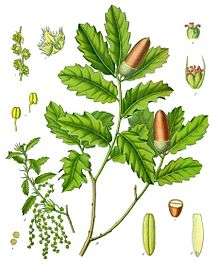Quercus lusitanica
| Gall oak | |
|---|---|
 | |
| Quercus lusitanica[1] | |
| Scientific classification | |
| Kingdom: | Plantae |
| (unranked): | Angiosperms |
| (unranked): | Eudicots |
| (unranked): | Rosids |
| Order: | Fagales |
| Family: | Fagaceae |
| Genus: | Quercus |
| Section: | Lepidobalanus |
| Species: | Q. lusitanica |
| Binomial name | |
| Quercus lusitanica Lam. 1785 | |
| Synonyms[2] | |
|
List
| |
Quercus lusitanica, commonly known as gall oak, Lusitanian oak, or dyer's oak, is a species of oak native to Morocco, Portugal, and Galicia.[3] Quercus lusitanica is the source of commercial nutgalls. These galls are produced by the infection from the insect Cynips gallae tinctoriae. They are used for dyeing.
Several other species are known colloquially as "gall oaks;" indeed, galls can be found on a large percentage of oak species.[4] The specific epithet "lusitanica" refers to the ancient Roman Province of Lusitania, corresponding roughly to present-day Portugal.[5]
References
- ↑ 1897 illustration from Franz Eugen Köhler, Köhler's Medizinal-Pflanzen
- ↑ The Plant List, Quercus lusitanica Lam.
- ↑ Kew World Checklist of Selected Plant Families
- ↑ Cranshaw, Whitney (2004). Garden Insects of North America. Princeton, New Jersey: Princeton University Press. ISBN 0-691-09560-4.
- ↑ Garcia, José Manuel (1989). História de Portugal: Uma Visão Global. Lisboa: Editorial Presença. pp. 32, 33, 38. ISBN 9722309897.
External links
This article is issued from Wikipedia - version of the 7/4/2016. The text is available under the Creative Commons Attribution/Share Alike but additional terms may apply for the media files.